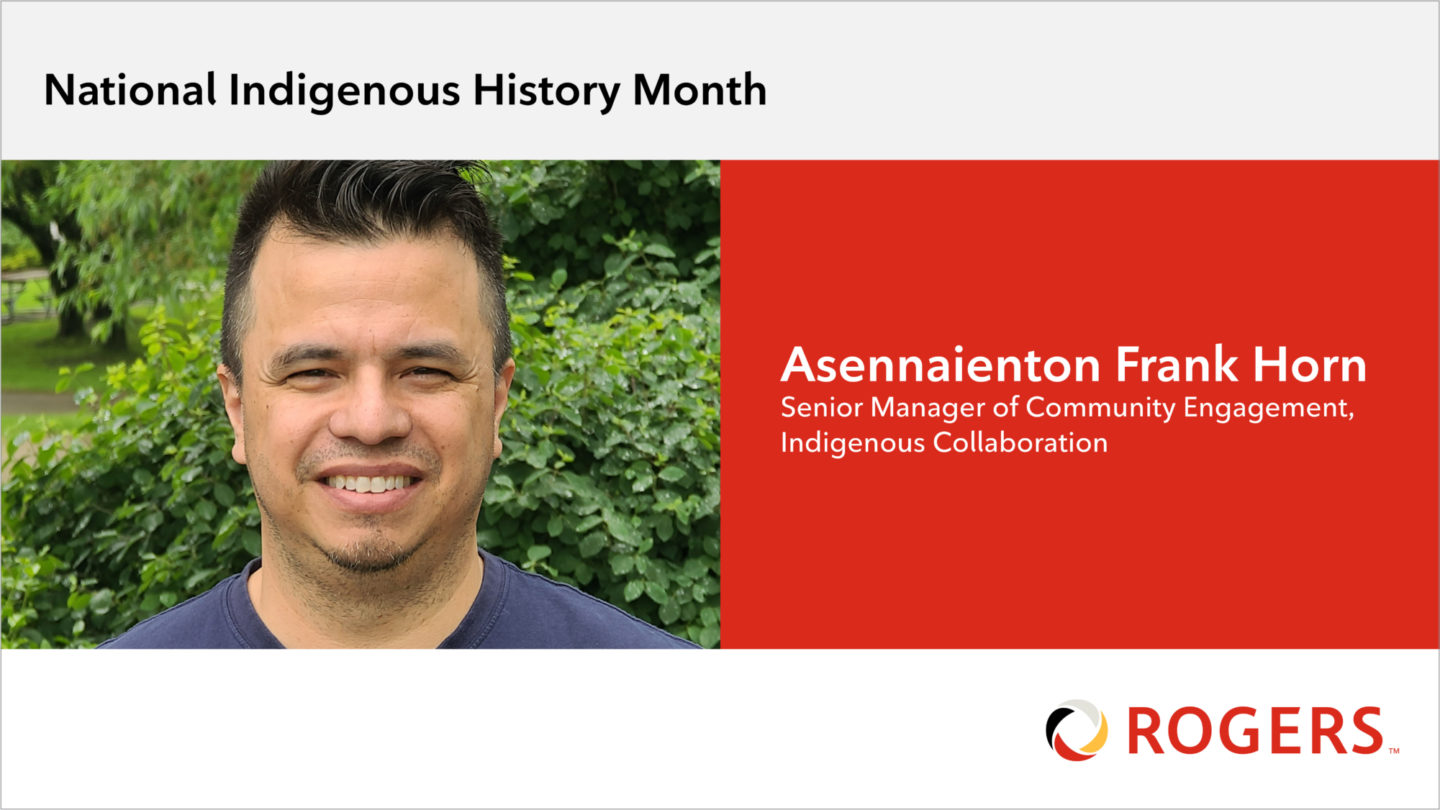National Indigenous History Month: Rogers Employee Asennaienton Frank Horn discusses the importance of storytelling

Throughout National Indigenous History Month we’ll be spotlighting personal and inspiring stories from a few Indigenous team members. Here’s Frank’s story.
National Indigenous History Month is a dedicated time each year for learning and acknowledging the distinct heritage, languages, cultural practices, and spiritual beliefs of Indigenous people. In honour of National Indigenous History Month, a few Indigenous team members will be sharing their stories.
Asennaienton Frank Horn, (Asennaienton being his Mohawk name) the Senior Manager of Community Engagement, Indigenous Collaboration at Rogers. With a strong Indigenous family lineage – Kanien’kehá = “People of the Flint” from the sister communities of Kahnawake (near Montreal QC) on his fathers side, and Kanesatake (near Oka QC) and of the bear “ohkwari” clan on his mother’s side - here Frank shares more about his family history, the impact of his role at Rogers and his journey of learning the Kanien’keha (Mohawk) language.
This is Frank’s story.
You mentioned your parents met at a “haudenosaunee” a traditional longhouse social event. Can you share more about what a longhouse social consists of?
My parents are from neighbouring sister communities near Montreal, and were both raised in the ways of the longhouse “Haudenosaunee.” All of my grandparents spoke Kanien’keha (Mohawk), and knew very little French or English. There are many Kanien’keha ceremonies which can be very intricate and prolonged, my parents met a longhouse social before marrying and starting a family. An important element is the connection to clan. My dad is of the wolf clan and my mom of the bear clan. Since Haudenosaunee is matriarchal, I too am of the bear clan. This family structure system has been in place long before the colonial government Indian Act system was imposed. This imposition is patriarchal, which has never been the Haudenosaunee way and has created social chaos in the community.
Your Father was one of the first Indigenous lawyers in Canada, can you share why this is important and what this means to you?
My father shared stories of the struggle to finally graduate law school and pass the bar. It wasn’t easy. Partly because he had a young family at the time, but mainly because of systemic barriers. There was a time when it was illegal in Canada for any status Indian to have legal representation, much less become a lawyer. It was even illegal for a lawyer to represent a status Indian client otherwise they could be disbarred. This eventually changed and presented an opportunity where my dad did a pre-law summer program in Saskatchewan before going to McGill law school in the early ‘70s.
As I started my own family and understood the pressures of responsibility, I learned to admire my dad’s perseverance through during a very different time.
What are some of your most cherished traditions from your parents?
As I grew older and reflected about my upbringing, I realized the value of storytelling. Like many Indigenous tribes across turtle island, Kanien’keha (the “People of the Flint” (i.e. Mohawk)) is an oral culture, where all stories, ceremonies and traditions are passed through story. Both of my parents are wonderful story tellers, and I firmly believe these traits were passed on by their parents and so on before. The stories are vibrant with visual imagery to make it easier to reshare.
Each week I’m on a zoom call to learn Kanien’keha (Mohawk) with my family, where my mom and her sister (my auntie) spend time teaching us the language. It’s not easy at my stage in life, but I work at it because it’s who I am. As we delve into Kanien’keha, the language is a philosophy and a way of life – where word structures are rich and beautiful. Some day I hope to be fluent enough to carry on a conversation, in the meantime I’m enjoying the power of the story.
As the Senior Manager of Community Engagement, Indigenous Collaboration at Rogers, what does your typical day-to-day look like?
The day can be varied but that’s okay, predictability bores me. Some days I spend time connecting and reconnecting with Indigenous communities to see how Rogers can help. This all starts with listening and letting the community drive the conversation. Each opportunity is different so the proposed solution could be different as well. The complexity and nuance of community really makes the work exciting. Some conversations are very preliminary, while others are detailed as we’re now at the build-out stage of a project. One of the best parts of the job is feeling a community’s excitement knowing they will have the same connectivity as any major urban centre.
The Indigenous Collaboration (IC) team also provides guidance on internal Rogers initiatives. This too has been wonderful, as these internal conversations have provided an opportunity for entire IC team to meet new colleagues. I have realized there are many allies here at Rogers who are passionate about moving the needle forward on the Indigenous file.
What is something you want your Rogers team members and allies of the Indigenous community to know during National Indigenous History month and year round?
From a connectivity perspective, it’s about opportunity. What Rogers is offering with broadband and wireless services is a path forward towards positive change. The colonial system that prohibited any advancement of the Indigenous community and the narrative needs to change. There is a definite chasm that needs to be bridged and Rogers offers the opportunity for equal footing. The Indigenous community is just as creative, just as innovative and just as entrepreneurial as the next, they just need the platform. Instead of always having to leave their home territory, why not be productive in the very land that is the source for all this creativity? That to me is the opportunity Rogers has within the Indigenous space!